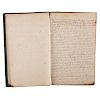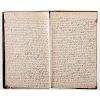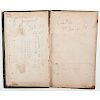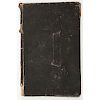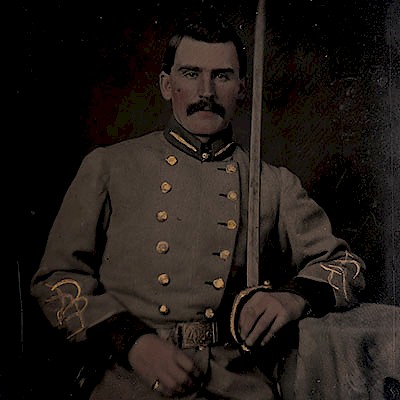Civil War Diary of Private James L. Lee, 147th Pennsylvania Infantry, Incl. Gettysburg, Missionary Ridge, Ringgold, and More
About Seller
6270 Este Ave.
Cincinnati , OH 45232
United States
With offices in Cincinnati, Cleveland and Denver, Cowan’s holds over 40 auctions each year, with annual sales exceeding $16M. We reach buyers around the globe, and take pride in our reputation for integrity, customer service and great results. A full-service house, Cowan’s Auctions specializes in Am...Read more
Two ways to bid:
- Leave a max absentee bid and the platform will bid on your behalf up to your maximum bid during the live auction.
- Bid live during the auction and your bids will be submitted real-time to the auctioneer.
Bid Increments
| Price | Bid Increment |
|---|---|
| $0 | $25 |
| $500 | $50 |
| $1,000 | $100 |
| $2,000 | $250 |
| $5,000 | $500 |
| $10,000 | $1,000 |
| $20,000 | $2,500 |
| $50,000 | $5,000 |
| $100,000 | $10,000 |
About Auction
Jun 22, 2018
Cowan’s American History: Premier Auction, scheduled for June 22, 2018 is comprised of early photographs, documents, manuscripts, broadsides, flags, and more dating from the Revolutionary War, the Civil War, Late Indian Wars, World War I and II and beyond. Cowan's Auctions dawnie@cowans.com
- Lot Description
Pocket diary of Private James L. Lee, spanning July 3, 1863, to December 30, 1863, comprising 62 pages of dense text in black ink, with notes and calculations on the remaining pages. A particularly well-written diary with many pages of descriptive battle content.
Lee enlisted as a private in Co. P of the 28th Pennsylvania Infantry on December 23, 1861, and served 13 months with the regiment before his entire company was transferred into the 147th as Co. E. This diary begins on the third day of the Battle of Gettysburg and ends December 30, 1863, as Pvt. Lee resides in a military hospital near Murfreesboro, TN, recovering from a foot wound sustained at the Battle of Ringgold Gap. It begins mid-sentence with a description of the Union overcoming the Confederate lines on that final day of Gettysburg: [The rebels] “charged but in a confused and irregular manner. Before they could reload we gave them another well-directed, solid volley which completely broke their ranks and drove them back in disorder leaving their dead and wounded upon the field. Our line immediately advanced and took possession of the entrenchments which had been held by the enemy for about 12hours. This closed the fighting on the right of the turnpike. The enemy made no further demonstrations on that part of our line in any considerable force, but as soon as the strife ceased here, it opened up with terrific fury all along our lines from Cemetery Hill to our extreme left.” A detailed account of the rest of the day follows for many lines: …”shot and shell crashed through the trees and tore up the ground in every direction”…”wagon trains and columns of relieved soldiers were constantly being moved from one position to another to gain cover from the shower of iron”…”the rattling volleys of musketry in a short time became a deep and continuous roll”…”every charge made by the enemy, although skillfully planned and daringly executed, was met and successfully repulsed by the soldiers of the Union”… and so on, including names of those dead and wounded in the 147th.
The next day’s entry begins, “This morning we begin to learn the particulars concerning the extent and completeness of our victory,” followed by the first accounts of the total numbers of casualties and prominent commanders to fall on both sides, and the efforts to bury the many dead. “Their dead lie thick in every part of the battlefield, at least 3 of them to 1 of ours.” Lee closes with accounts of the other Lee’s retreat and the Union’s pursuit. The following several days’ entries are all quite lengthy, with updated war news and descriptions of the march south, including skirmishes beginning around the Antietam battlefield. By July 16, his unit has made it to near Harper’s Ferry, where they are able to wash and change clothing for the first time in nearly a month, and receive news of the surrender of Port Hudson and splitting of the Confederacy into two parts, giving false hope that “the prospect of a speedy termination of the war grows brighter every day.” Lee also remarks on the New York City draft riots transpiring over the previous few days, saying “the traitors of NY have no friends here; nothing would suit the soldiers better than to be entrusted with the duty of putting them down and enforcing the draft.
The next two months pass relatively uneventfully, with only a couple of skirmishes and the arrival of new regiments and war news breaking up “the monotony of camp” near Culpepper, Virginia. The entries get significantly longer and more interesting again staring on September 15, when the 147th was “rigorously inspected” by Gen. Geary and immediately ordered to march toward Kelley’s Ford, where the next afternoon they found themselves “encamped apparently in the line of battle” and exchanged fire with the enemy around Rapidan Station over the next few days. The entry for September 18 is particularly notable, describing how Pvt. Lee’s picket detail was summoned back to camp to witness the execution of two deserters from the 78th New York. The condemned men were ordered to kneel in their coffins to face the firing squad, but the squad only succeeded in killing one, leaving the other badly wounded. A second firing party was ordered to finish the job, but they do failed to deliver a fatal shot and it took a third party to finish the job. Despite this “awful bungling” which “rendered the tragic performance far more cruel to the prisoners than the execution of their sentences demanded and more frightful for the spectators than necessary,” Lee says most of the veteran soldiers “heartily endorsed” the penalty as it was said to have reduced desertions by 50%.
Lee’s regiment is ordered west at the end of September, and he describes the journey by rail through the new state of West Virginia to Ohio, where he describes a warm welcome and day stop in Columbus, on to Indiana, south through Louisville and Nashville, ultimately disembarking near Murfreesboro, where they were almost immediately ordered to the line of battle. Over the next month they slowly moved toward Chattanooga. The Nov. 24-27 entries are some of the longest and most important, describing the assault of Lookout Mountain, the Battle of Missionary Ridge, and the Battle of Ringgold Gap in great detail, ending with Lee’s matter-of-fact statement that he was wounded in the right foot in the second charge at Ringgold. The final month of entries describes his day-to-day life in Union hospitals as he recovers, being moved several times by the end of the year. It is not known to us if he ever returned to service or what happened to Lee in 1864, but records show he mustered out on Sept. 26 of that year.
Eliminate the Hassle of Third-Party Shippers: Let Cowan's Ship Directly To You!Condition
If you'd like a shipping estimate before the auction, contact Cowan's in-house shipping department at shipping@cowans.com or 513.871.1670 x219. - Shipping Info
-
Buyers are required to pay for all packing, shipping and insurance charges. Overseas duty charges are the responsibility of the successful Bidder. Be aware that for larger and/or valuable items, shipping charges can be substantial. - If there is no shipping amount on listed your invoice, you will need to make arrangements to pick up or ship your purchase through an alternative shipping company. Our shipping department can be contacted at 513.871.1670 (ext. 219) or email shipping@cowans.com. - Shipping charges include insurance for your order while in transit. If you have private insurance we will adjust your charge to include only packing and shipping. - Please allow 14 – 21 days after payment to package and ship your purchase as carefully as possible.
-
- Buyer's Premium



 EUR
EUR CAD
CAD AUD
AUD GBP
GBP MXN
MXN HKD
HKD CNY
CNY MYR
MYR SEK
SEK SGD
SGD CHF
CHF THB
THB
